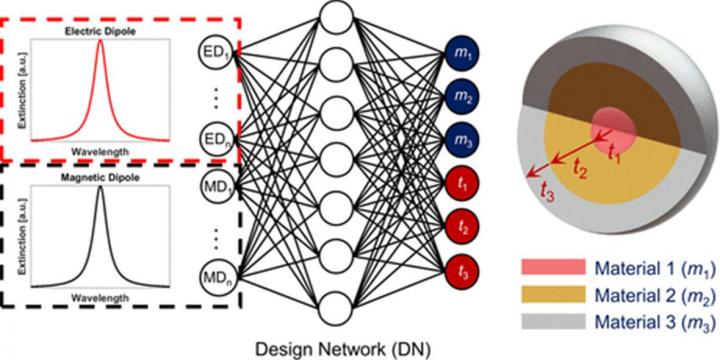The research team led by professor Rho of POSTECH developed a simultaneous inverse design of metamaterials via deep learning

Credit: POSTECH
Metamaterials are artificial materials engineered to have properties not found in naturally occurring materials and they are best known as materials for the ‘invisibility cloak’ often featured in SF novels or games. By precisely designing artificial atoms that are smaller than the wavelength of light and controlling the polarization and spin of light, new optical properties are made that are not found in nature. However, the current process require numerous trial and failures until the right material is obtained. It is not only time consuming but also compromise efficiency. And AI is expected to provide a solution for this problem.
The research group of Prof. Junsuk Rho, Sunae So and Jungho Mun of Department of Mechanical Engineering and Department of Chemical Engineering at POSTECH developed a design with a higher degree of freedom which allows to choose materials and to design photonic structures arbitrarily by using Deep Learning. Their findings are published in several renowned journals such as the Applied Materials and Interfaces, Nanophotonics, Microsystems & Nanoengineering, Optics Express, and Scientific Reports. As they published their findings in five journals a month, they have attracted tremendous attention from the field of academics.
Properties of metamaterials depend on the way they are designed. The conventional intuitive-based and labor-intensive design has been suggested as a problem due to repetitive trial and error process. However, Prof. Rho and his team suggested a new data-based design method by utilizing AI.
AI can be trained with a vast amount of data and it can learn designs of various metamaterials and the correlation between photonic structures and their optical properties. Using this training process, it can provide a design method that makes a photonic structure with desired optical properties. Once trained, it can provide a desired design promptly and efficiently. This has already been researched at various institutions in the U.S.A such as MIT, Stanford University, Georgia Institute of Technology. However, the previous studies require inputs of materials and structural parameters of structures beforehand and adjust photonic structures afterwards.
Prof. Rho and his group educated AI to design arbitrary photonic structures and gave additional level of freedom of the design by categorizing types of materials and adding them as a design factor, which made it possible to design appropriate materials for relevant optical properties. Analysis of metameterials obtained through this design method revealed that it had identical optical properties inputted in the artificial neural network.
The research team, who have published various research findings on the design of metamaterials and optics theory, put enormous efforts in this research by studying the programming language, Python, needed to learn Deep Learning with online courses, MOOC.
Their accomplishment of developing this design method is revolutionary in many ways. First of all, it significantly reduced the time needed to design photonic structures. Also, it allows various designs of new metamaterials because scientists are no longer limited to conduct empirical designs to obtain results. Metamaterials can be utilized in applications such as display, security, and military technology but all within the limits of development stage at the moment. In this regard, introduction of AI to the design method is expected to make important contribution to the technological development of metamaterials.
Prof. Junsuk Rho, the lead-researcher in the team, commented that, “Our research was successful in bringing it to a higher degree of freedom of the design, but the new design still requires users to input certain problem settings in the beginning. It sometimes produced wrong designs and therefore make it impossible to produce desired metamaterials. So, I’d like to take our findings a step further by developing a complete design method of metamaterials utilizing AI. Also, I’d like to make innovative and practical metamaterials by training AI with reviews of the design constructed in consideration of final products.
###
This research was funded by the Ministry of Science and ICT and the National Research Foundation of Korea.
Media Contact
Hyeyong Choi
[email protected]
Related Journal Article
http://dx.




